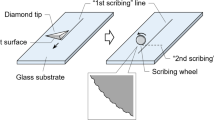Abstract
We present an indentation-scope that interfaces with confocal microscopy, enabling direct observation of the three-dimensional (3D) microstructural response of coatings on substrates. Using this method, we compared microns-thick polymer coatings on glass with and without silica nanoparticle filler. Bulk force data confirmed the >30% modulus difference, while microstructural data further revealed slip at the glass-coating interface. Filled coatings slipped more and about two times faster, as reflected in 3D displacement and von Mises strain fields. Overall, these data indicate that silica-doping of coatings can dramatically alter adhesion. Moreover, this method compliments existing theoretical and modeling approaches for studying indentation in layered systems.







Similar content being viewed by others
References
P. Garcia Parejo, M. Zayat, and D. Levy: Highly efficient UV-absorbing thin-film coatings for protection of organic materials against photodegradation. J. Mater. Chem. 16, 2165 (2006).
S. Hu, N.S. Lewis, J.W. Ager, J. Yang, J.R. McKone, and N.C. Strandwitz: Thin-film materials for the protection of semiconducting photoelectrodes in solar-fuel generators. J. Phys. Chem. C 119, 24201 (2015).
D. Wang and G.P. Bierwagen: Sol-gel coatings on metals for corrosion protection. Prog. Org. Coat. 64, 327 (2009).
J.E. Ritter, W. Gu, and T.J. Lardner: Effectiveness of polymer coatings on reducing indention damage in glass. Polym. Eng. Sci. 32, 1372 (1992).
A.J. Kinloch, R.D. Mohammed, A.C. Taylor, C. Eger, S. Sprenger, and D. Egan: The effect of silica nano particles and rubber particles on the toughness of multiphase thermosetting epoxy polymers. J. Mater. Sci. 40, 5083 (2005).
G. Ragosta, M. Abbate, P. Musto, G. Scarinzi, and L. Mascia: Epoxy-silica particulate nanocomposites: chemical interactions, reinforcement and fracture toughness. Polymer 46, 10506 (2005).
H. Zhang, Z. Zhang, K. Friedrich, and C. Eger: Property improvements of in situ epoxy nanocomposites with reduced interparticle distance at high nanosilica content. Acta Mater. 54, 1833 (2006).
T.H. Hsieh, A.J. Kinloch, K. Masania, J.S. Lee, A.C. Taylor, and S. Sprenger: The toughness of epoxy polymers and fibre composites modified with rubber microparticles and silica nanoparticles. J. Mater. Sci. 45, 1193 (2010).
J.E. Ritter, D.R. Sioui, and T.J. Lardner: Indentation behavior of polymer coatings on glass. Polym. Eng. Sci. 32, 1366 (1992).
J.E. Ritter, T.J. Lardner, L. Rosenfeld, and M.R. Lin: Measurement of adhesion of thin polymer coatings by indentation. J. Appl. Phys. 66, 3626 (1989).
H. Chai, B. Lawn, and S. Wuttiphan: Fracture modes in brittle coatings with large interlayer modulus mismatch. J. Mater. Res. 14, 3805 (1999).
S.J. Bull: A simple method for the assessment of the contact modulus for coated systems. Philos. Mag. 95, 1907 (2015).
D. Lee, M.M. Rahman, Y. Zhou, and S. Ryu: Three-dimensional confocal microscopy indentation method for hydrogel elasticity measurement. Langmuir 31, 9684 (2015).
R.B. King: Elastic analysis of some punch problems for a layered medium. Int. J. Solids Struct. 23, 1657 (1987).
N. Hakiri, A. Matsuda, and M. Sakai: Instrumented indentation microscope applied to the elastoplastic indentation contact mechanics of coating/substrate composites. J. Mater. Res. 24, 1950 (2009).
D. Silbernagl and B. Cappella: Mechanical properties of thin polymer films on stiff substrates. Scanning 32, 282 (2010).
A.K. Bhattacharya and W.D. Nix: Analysis of elastic and plastic deformation associated with indentation testing of thin films on substrates. Int. J. Solids Struct. 24, 1287 (1988).
W. Hirst and M.G.J.W. Howse: The indentation of materials by wedges. Proc. R. Soc. Lond. Math. Phys. Eng. Sci. 311, 429 (1969).
X.-L. Gao, X.N. Jing, and G. Subhash: Two new expanding cavity models for indentation deformations of elastic strain-hardening materials. Int. J. Solids Struct. 43, 2193 (2006).
J.E. Ritter and L.G. Rosenfeld: Use of the indentation technique for studying delamination of polymeric coatings. J. Adhes. Sci. Technol. 4, 551 (1990).
S.J. Bull: Nanoindentation of coatings. J. Phys. Appl. Phys. 38, R393 (2005).
M. Li, M.L. Palacio, C. Barry Carter, and W.W. Gerberich: Indentation deformation and fracture of thin polystyrene films. Thin Solid Films 416, 174 (2002).
N.Y.C. Lin, J. McCoy, X. Cheng, B. Leahy, J.N. Israelachvili, and I. Cohen: A multi-axis confocal rheoscope for studying shear flow of structured fluids. Rev. Sci. Instrum. 85, 033905 (2014).
J.C. Crocker and D.G. Grier: Methods of digital video microscopy for colloidal studies. J. Colloid Interface Sci. 179, 298 (1996).
L. Bartell: Barnes interpolation (Barnes objective analysis). Version 1.3. MATLAB Central File Exchange.
W. Liu and R. Long: Constructing continuous strain and stress fields from spatially discrete displacement data in soft materials. J. Appl. Mech.-Trans. Asme 83, 011006 (2016).
J. Lee and A.F. Yee: Fracture of glass bead/epoxy composites: on micro-mechanical deformations. Polymer 41, 8363 (2000).
G.R. Gossweiler, G.B. Hewage, G. Soriano, Q. Wang, G.W. Welshofer, X. Zhao, and S.L. Craig: Mechanochemical activation of covalent bonds in polymers with full and repeatable macroscopic shape recovery. ACS Macro Lett. 3, 216 (2014).
A.-D.N. Celestine, B.A. Beiermann, P.A. May, J.S. Moore, N.R. Sottos, and S.R. White: Fracture-induced activation in mechanophore-linked, rubber toughened PMMA. Polymer 55, 4164 (2014).
Acknowledgments
L.R.B. was supported by an award from Corning Research and Development Corporation to Cornell University. N.Y.C.L. and I.C. were supported by NSF DMR-CMP 1507607. J.L.L., M. L.S., D.A.C., M.J.L., J.R.M., G.S.G., and M.E.D. are employees of Corning Research and Development Corporation.
Author information
Authors and Affiliations
Corresponding author
Supplementary material
Supplementary material
The supplementary material for this article can be found at https://doi.org/10.1557/mrc.2017.114.
Rights and permissions
About this article
Cite this article
Bartell, L.R., Lin, N.Y.C., Lyon, J.L. et al. Three-dimensional microscale flow of polymer coatings on glass during indentation. MRS Communications 7, 896–903 (2017). https://doi.org/10.1557/mrc.2017.114
Received:
Accepted:
Published:
Issue Date:
DOI: https://doi.org/10.1557/mrc.2017.114




